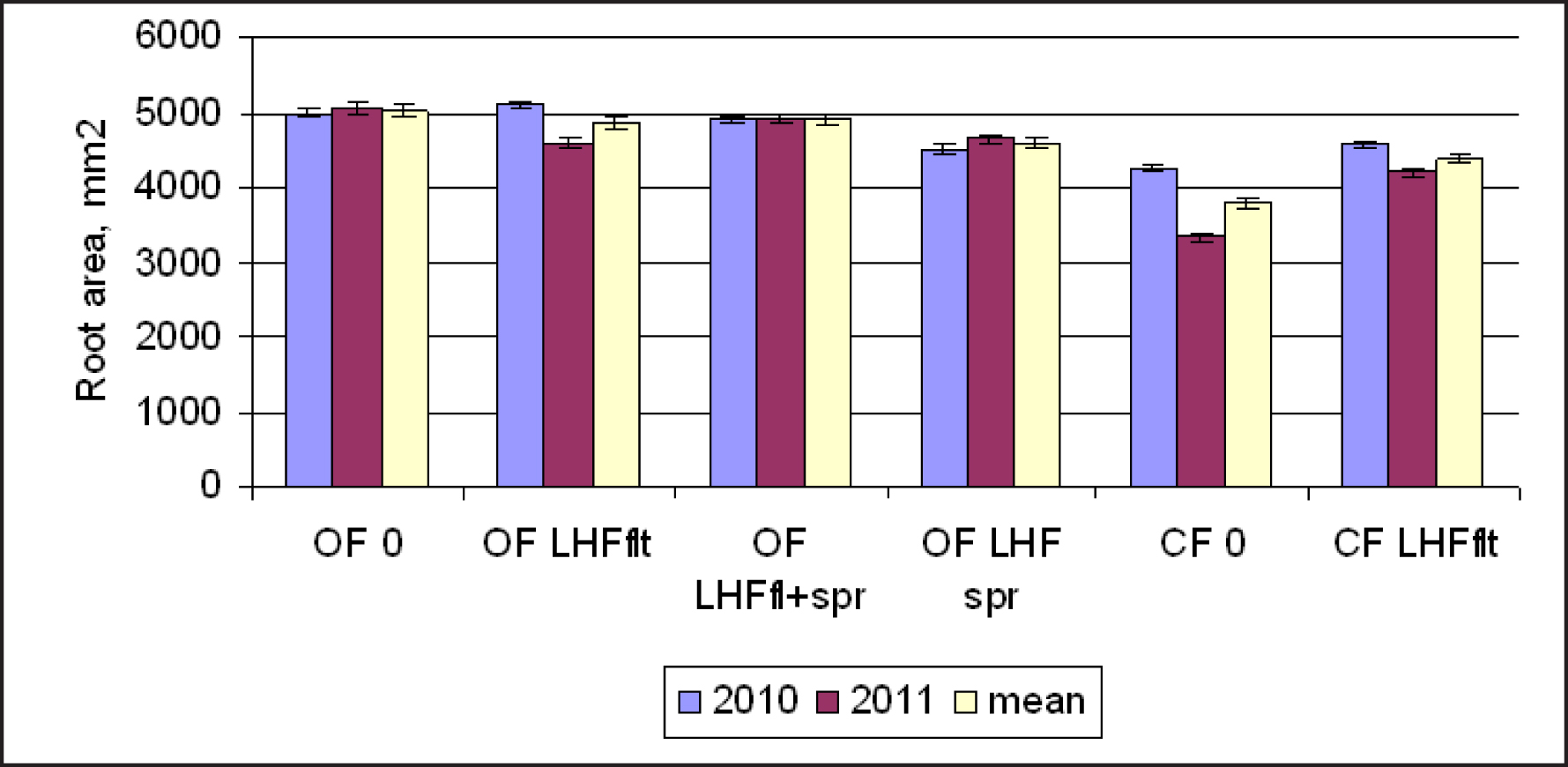Winter wheat morphology response to cold temperature stress during autumn acclimation
Abstract
Winter wheat (Triticum aestivum L.) abilities depend on development during autumn acclimation. The plant ability of acclimation to low temperatures is closely associated with the photosynthesis level, leaf area index (LAI), root system development. This study investigated the effect of liquid humic fertilizers (LHF) on biometric characteristics, namely LAI, root and shoot development. The fertilizers were applied in conventional and organic growth technologies of w. wheat to adapt to the low temperatures during autumn acclimation.
Winter wheat «Širvinta 1» was grown in different rotation fields of conventional (CF; Albi-EpihypogleyicLuvisol, LVg-p-w-ab) and organic (OF; Hapli-EpihypogleyicLuvisol, LVg-p-w-ha) farming of Training Farm at Aleksandras Stulginskis University (ASU) during 2010–2011.
The obtained results confirmed the significant LHF influence on enhancing winter wheat biometrical indices and seedling growth. Nonetheless, seed felting exhibited stronger effect on LAI (increased by 0.7-1.1 g m-1 day-1 in OF and 0.25-0.7 g m-1 day-1 in CF), root length (increased by 1166 mm in OF and 1182.55 mm in CF) and area (increased by 72.45 mm2 in OF and 588.7 mm2 in CF) during autumn acclimation rather than seedling spraying.
References
Breda N.J.J. 2003. Ground-based measurements of leaf area index: A review of methods, instruments and current controversies. J. Exp. Bot. 54: 2403–2417.
Cowlinf S.A. & Field C.B. 2003. Environmental control of leaf area production: Implications for vegetation and land-surface modeling. Global.Biogeochem. Cy. 17 (1): 1–14.
Equiza M.A., Miravé J.P., Tognetti J.A. 2001. Morphological, anatomical and physiological responses related to differential shoot vs. root growth inhibition at low temperature in spring and winter wheat. Ann. Bot. 87: 67–76.
FAO/UNESCO 1997. Soil map of the world revised legend with corrections and updates. Techn. Paper 20: 1–140. ISRIC, Wageningen.
Hassan I.A. 2006. Effects of water stress and high temperature on gas exchange and chlorophyll fluorescence in Triticum aestivum L. Photosynth. 44: 312–315
Herman E.M., Rotter K., Premakumar R. et al. 2006. Additional freeze hardiness in wheat acquired by exposure to −3°C is associated with extensive physiological, morphological, and molecular changes. J. Exp. Bot. 57: 3601–3618.
Houlès V., Guérif M., Mary B. 2007. Elaboration of a nitrogen nutrition indicator for winter wheat based on leaf area index and chlorophyll content for making nitrogen recommendations. Eur. J. Agron. 27: 1–11.
Jackson R.B., Mooney H.A., Schulze E.–D. 1997. A global budget for fine root biomass, surface area, and nutrient contents. Proc. Nat. Acad. Sci. USA, Ecol. 94: 7362–7366.
Kosová K.P. Vítámvás I. Prášil T. 2011. Expression of dehydrins in wheat and barley under different temperatures. Plant Sc. 180: 46–52.
Liu H.S., Li F.M., Xu H. 2004. Carbon consumption of roots and its relationship to yield formation in spring wheat as affected by soil moisture. Acta Phytoec. Sin. 28: 191–197.
Meier U. (ed.). 2001. Growth stages of mono-and dicotyledonous plants. BBCH Monograph. IGZ, Erfurt.
Peñuelas J., Gamon J.A., Fredeen A.L. et al. 1994. Reflectance indices associated with physiological changes in nitrogen- and water-limited sunflower leaves. Rem. Sens. Envir. 48: 135–146.
Raven P.H., Evert R.F., Eichhorn S.E. 2005. Photosynthesis, light and life. In: Raven P.H., Evert R.F., Eichhorn S.E. Biology of plants. 7th ed.: 119–127. W.H. Freeman and Company, New York.
Rinalducci S., Egidi M.G., Mahfoozi S. et al. 2011. The influence of temperature on plant development in a vernalization-requiring winter wheat: A 2-DE based proteomic investigation. J. Prot. 74: 643–659.
Saidi A., Ookawa T., Hirasawa T. 2010. Responses of root growth to moderate soil water deficit in wheat seedlings. Plant Prod. Sc. 13: 261–268.
Sellers P.J., Berry J.A., Collatz G.J. et al. 1992. Canopy reflectance, photosynthesis, and transpiration. III. A reanalysis using improved leaf models and a new canopy integration scheme. Rem. Sens. Envir. 42: 187–216.
Sellers P.J., Meeson B.W., Hall F.G. et al. 1995. Remote sensing of the land surface for studies of global change: Models – algorithms – experiments. Rem. Sens. Envir. 51: 3–26.
Streck N.A., Weiss A., Baenziger P.S. 2003. A generalized vernalization response function for winter wheat. Agr. J. 95: 155–159.
Stupnikova I.V., Borovskii G.B., Dorofeev N.V. et al. 2002. Accumulation and disappearance of dehydrins and sugars depending on freezing tolerance of winter wheat plants at different developmental phases. J. Therm. Biol. 27: 55–60.
Vińa A., Gitelson A.A., Nguy-Robertson A.L., Peng Y. 2011. Comparison of different vegetation indices for the remote assessment of green leaf area index of crops. Rem. Sens. Envir. 11: 3468–3478.
Xin Z. & Browse J. 2000. Cold comfort farm: the acclimation of plants to freezing temperatures. Plant Cell Envir. 23: 893–902.


This work is licensed under a Creative Commons Attribution-NonCommercial-NoDerivatives 4.0 International License.
The journal is licensed by Creative Commons under BY-NC-ND license. You are welcome and free to share (copy and redistribute the material in any medium or format) all the published materials. You may not use the material for commercial purposes. You must give appropriate credit to all published materials.
The journal allow the author(s) to hold the copyrights and to retain publishing rights without any restrictions. This is also indicated at the bottom of each article.





